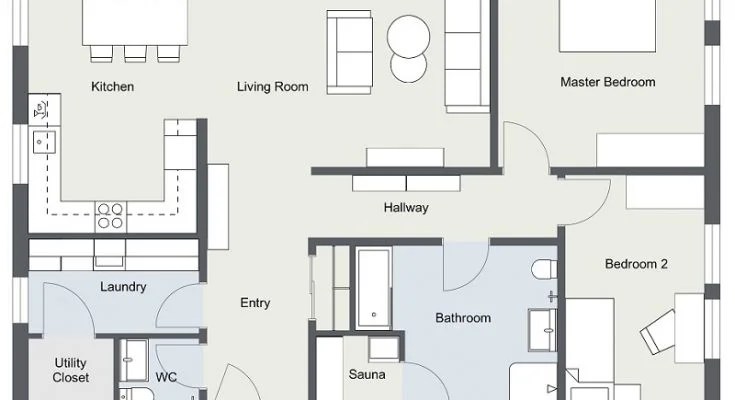Can I Get The Original Plans For My House? A Comprehensive Guide
The question of accessing original house plans is a common one among homeowners, particularly when considering renovations, expansions, or simply seeking a deeper understanding of their property's construction. While the existence and accessibility of these plans can vary significantly, understanding the potential sources, legal considerations, and practical hurdles is crucial. This article explores the various avenues for locating original house plans and provides insights into the factors that influence their availability.
The term "original house plans" generally refers to the architectural drawings and specifications created during the initial design and construction phase of a residential property. These plans typically include detailed floor plans, elevation views, structural details, and information on plumbing, electrical, and HVAC systems. They represent a comprehensive record of the building's intended design and construction, offering invaluable information for future modifications or repairs.
The desire to obtain these plans stems from various needs. Homeowners may require them for planning a home addition, remodeling a kitchen or bathroom, or understanding the location of hidden utilities before undertaking DIY projects. Furthermore, access to original plans can be crucial when addressing structural issues or making significant alterations that require building permits. The plans provide a roadmap for the existing structure, allowing architects and contractors to accurately assess the feasibility and impact of proposed changes. They also serve as a historical record of the house’s design, which can be of interest to those researching their home's history or architectural style.
Understanding Potential Sources of Original House Plans
The first step in locating original house plans involves identifying potential sources where these documents might be stored. The likelihood of finding them depends on several factors, including the age of the house, the builder or architect involved, and local record-keeping practices.
Local Government Archives: City and county building departments are often the most reliable repository for original house plans. When a building permit is issued, a set of approved plans is typically submitted to the local government for record-keeping purposes. These archived plans can be accessed by homeowners by submitting a request to the relevant department. However, accessing these records may require providing specific information, such as the property address, the original building permit number (if known), and proof of ownership. Many municipalities are transitioning their records to digital formats, making online searches possible, while others still rely on physical archives that necessitate in-person visits. The availability of records varies widely; some municipalities have retained extensive archives dating back decades, while others may have limited records, particularly for older properties. Furthermore, some jurisdictions may have policies regarding the confidentiality of certain information contained within the plans, requiring redaction before public release.
The Original Builder or Architect: If the house was built relatively recently or by a local builder, contacting the original builder or architect is another viable option. These professionals often retain copies of the plans they created, especially if they were involved in several projects within the same neighborhood or community. If the builder or architect is still in business, contacting them directly may yield the desired plans. If the original company no longer exists, trying to trace their legacy through industry associations or historical records may lead to contact with former employees or successors who might possess copies of the plans. However, keep in mind that architects and builders are not always obligated to keep plans indefinitely, so their availability is not guaranteed.
Previous Homeowners: Sometimes, the simplest solution is the most effective. Previous homeowners may have retained copies of the original house plans, either due to their own interest in renovations or as part of the original closing documents. Reaching out to former owners, if possible, can be a surprisingly fruitful endeavor. Title companies or real estate agents may be able to help connect current homeowners with the previous owners, particularly if the property was sold recently. Even if the previous owners do not have the complete original plans, they might possess partial drawings, specifications, or related documents that can be helpful in understanding the house's construction.
Title Companies and Mortgage Lenders: While less common, title companies and mortgage lenders might, in rare cases, have copies of original house plans as part of their due diligence process during the initial construction or a subsequent sale. This is more likely to occur if the house was part of a larger development or if the lender required detailed plans for valuation purposes. Checking with these institutions, especially those involved in the initial construction financing, could potentially uncover a hidden source of information.
Navigating Legal and Practical Considerations
Even if a potential source of original house plans is identified, several legal and practical considerations may impact accessibility. Understanding these factors is essential for navigating the process effectively.
Copyright and Intellectual Property Rights: Architectural plans are protected by copyright law, which means that the architect or designer who created the plans typically owns the intellectual property rights. While homeowners generally have the right to use the plans for their own purposes, such as renovations or repairs, making copies for distribution or commercial use is usually prohibited without the architect's consent. Building departments often have specific policies regarding the reproduction and use of archived plans to protect these intellectual property rights. Therefore, obtaining permission from the copyright holder may be necessary before making copies or using the plans extensively.
Privacy and Confidentiality: Original house plans may contain sensitive information about the property's layout, security systems, and utility infrastructure. Local governments and other record-keepers may have policies in place to protect the privacy of homeowners and prevent unauthorized access to this information. This may involve redacting certain details from the plans before making them available or requiring proof of ownership and a legitimate reason for accessing the documents. Additionally, some older plans may contain personal information about the original owners, which may be subject to privacy regulations and require special handling.
Accessibility of Archived Records: Physical archives maintained by local governments can be challenging to navigate. Records may be poorly organized, damaged, or incomplete. Accessing these records may require scheduling an appointment, paying a fee, and spending considerable time searching through physical files. Furthermore, the availability of staff to assist with the search may be limited, especially in understaffed or underfunded departments. Digitization efforts are gradually improving accessibility, but many older records are still only available in physical form. Understanding the specific policies and procedures of the local government archives is crucial for a successful search.
Building Codes and Regulations: Original house plans may not reflect current building codes and regulations. Codes evolve over time to address new technologies, safety concerns, and environmental standards. Using outdated plans for renovations or repairs without considering current codes can lead to violations, safety hazards, and costly rework. Therefore, it is essential to consult with a qualified architect or engineer to ensure that any modifications based on the original plans comply with current building codes. In some cases, substantial renovations may trigger requirements to bring the entire house up to current code, which can significantly impact the scope and cost of the project.
Alternative Strategies When Original Plans Are Unavailable
In many cases, obtaining original house plans proves difficult or impossible. Despite diligent efforts, the plans may be lost, destroyed, or simply inaccessible. In these situations, alternative strategies can provide valuable information about the house's construction and design.
Creating "As-Built" Drawings: If original plans are not available, commissioning an architect or draftsperson to create "as-built" drawings is a common solution. As-built drawings are accurate representations of the existing structure, based on measurements and observations taken on-site. These drawings can be used for planning renovations, obtaining building permits, or simply understanding the layout and dimensions of the house. Creating as-built drawings involves a detailed survey of the property, including measuring room sizes, wall thicknesses, window and door locations, and the location of utilities. The resulting drawings provide a reliable basis for design and construction planning, even in the absence of original plans.
Consulting with Experienced Contractors: Experienced contractors who have worked on similar houses in the area may have valuable insights into the typical construction methods and materials used during the house's era. They may be able to provide general information about the structural system, plumbing and electrical layout, and common details that can inform renovation plans. While not a substitute for original plans, this anecdotal evidence can be helpful in making informed decisions. Furthermore, contractors may have encountered similar construction challenges in other houses and can offer practical solutions based on their experience.
Researching Historical Records and Neighborhood Information: Researching historical records related to the property and the surrounding neighborhood can provide clues about the house's construction and design. This may involve examining old maps, historical photographs, property tax records, and local history archives. These sources can reveal information about the original builder, the architectural style, and the development patterns of the neighborhood, which can provide context for understanding the house's construction. Local historical societies and libraries are valuable resources for this type of research.
Utilizing Online Resources and Databases: Several online resources and databases offer information about house designs and construction practices. Websites dedicated to architectural styles, historical building techniques, and home improvement can provide general guidance and inspiration. Additionally, some websites offer searchable databases of house plans, although these plans may not be specific to the individual property. These resources can be helpful in understanding the house's design context and identifying potential solutions for renovations or repairs.
Professional Inspection and Assessment: Hiring a qualified home inspector or structural engineer to conduct a thorough inspection of the property can provide valuable insights into its condition and construction. These professionals can identify potential structural issues, assess the integrity of the building systems, and provide recommendations for repairs or improvements. Their expertise can be particularly helpful when original plans are unavailable, as they can provide a detailed assessment of the existing structure and identify any hidden problems. A comprehensive inspection report can serve as a valuable source of information for future renovations or repairs.

How To Get Blueprints Of Your House

How To Find The Original Floor Plans For Your House

Site Plans What They Are And How To Create One

House Plans How To Design Your Home Plan

How To Find The Plans Or Blueprints Your Old House

House Plans How To Design Your Home Plan

Floor Planner Cost Hiring Draftsperson Forbes Home

House Plans How To Design Your Home Plan

2024 Cost Of Drafting House Plans Blueprints Homeguide

House Plan Monticello Sater Design Collection








